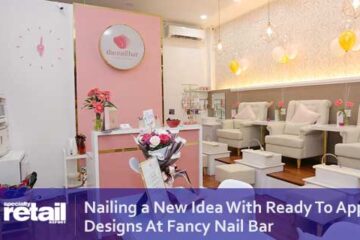The specter of competition from online retail strikes fear in the hearts of specialty retailers and mall developers everywhere. Although the Internet may offer shoppers speed, convenience and nifty visuals, tremendous opportunity exists for the brick-and-mortar marketplace. To take advantage of that opportunity, however, specialty retailers have to reinvent—or at least re-orient—themselves in order to compete successfully. The key is in creating visual appeal.
Websites use glitzy graphics and great photos, bright colors and stylish design—”eye candy”—that not only helps sell, but creates an ongoing, distinctive image and identity. Temporary and in-line retailers can—and should—do the same thing. In fact, smart retailers have been doing it all along: using effective product presentation to stand out from the crowd, and to sell merchandise. Today more than ever, specialty retailers must understand the fundamentals of product presentation, put them to work to create visually exciting shopping, and establish their own image and identity.
Presentation is the key. Store design and merchandising display must create a positive “sensory experience.” In other words, how your store or cart looks must send a visual message: “Come in! Shop here! This place is fun and exciting!” More than that, the message must be distinctly your own.
It’s about image.
Imagine your retail location as a stage, an entertainment platform on which you put your products in the best setting. Fixtures, layout, lighting, signs—everything at your location is designed to work together to enhance and support your product, to present the “star” of the show. By doing that, you create a retail environment that communicates an image, lifestyle or value system for the product and your business. It draws customers because it reflects their own image, lifestyle or value system—or one they’d like to adopt. That’s what they’re responding to.
Retailers who realize the importance of this concept are the ones who are creating today’s new standards. When you go into any Starbucks, for example, you immediately experience the Starbucks image, lifestyle and value system. In fact, you can’t miss it. The colors, furnishings, graphics, product displays and even the music work together to make a statement. Their message? Come into this place: Here you can rest, sit, talk, read, play board games—escape the hectic world and enjoy something delicious.
Similarly, Windsor Rose recently unveiled their new image. Messages on the walls, art and graphics, sculptural mannequins, curved lines and softer colors make a statement about this company’s image and values. Harley-Davidson is rolling out retail stores that bespeak their distinctive image and values in every aspect of design and product presentation.
Chains like these have huge design budgets, of course. But small retailers can create the same effect much more modestly. The trick is to decide the image you want your retail location to project and the message you want your products to communicate—that is, in what ways will they add meaning and improve life for your customers? Once you know that, create a plan so that everything works together to convey that message.
Define yourself
Presentation has never been more important. The successful retailer knows that customers respond to visual appeal. As a result, product presentation has tremendous impact on the bottom line. Look-alike and uninspired presentations that rely on price alone will not succeed in the face of new demands the marketplace is making.
To compete successfully, you as a specialty retailer need to create market difference. You have to make clear and obvious to the customer what sets you apart, and communicate that in unmistakable terms. In short, you have to define yourself. You must define and distinguish your retail business from the competition. And you need to do that with energy and drama—remember, your store is the stage, your products the star. Surround them with the best creative, vibrant, meaningful elements you can.
Getting noticed
A shopping center is a visually competitive place. The customer will give you one glance as she passes your cart or store. In those few seconds, its look must engage, invite, and define. Consider these elements to create that effect in those few seconds:
- Lighting—Use to highlight merchandise, and draw the eye. Track lighting creates the most appealing presentation.
- Displays—Coordinate by theme, color and category.
- Atmosphere—Create an “environment” for discovery by means of attractive visual organization.
Discovery is part of the drama and the image you create with good presentation. Shopping is “finding” and, for many shoppers, finding is fun (or at least satisfying). Cultivate that sense of discovery by creating an environment for browsing. Let interesting merchandise presentations be the first thing your customer experiences.
Fill their need to browse comfortably. Be a place where people linger and feel relaxed. Studies show that the longer a customer is in a store, the more they buy.
Putting it together
Present your merchandise in beautifully designed, color-coordinated displays that define your market niche. Check out who has excellent displays in your center and study the elements of the ones you like best. You can even inquire who did the display and see if that person is available for hire as a freelance. If you’re doing it yourself, keep it simple and stick to the fundamentals. Williams-Sonoma and Crate & Barrel are just two well-known examples of successful retailers who use these principles effectively. And so can you. Here are some ideas to get you started:
- Use two colors, with a third as an accent. Learn the basics of effective color coordination (there are numerous books that can help you).
- Use many units of the same item in rows or groupings.
- Create small groupings or modular “islands” of merchandise at different levels: a table or cube (especially if you sell from a cart); a small box on the table for the next level; a related item suspended from the ceiling above the box; and another surface under the table or cube.
- Use “pyramid” formations: larger items on the bottom, small or tall ones at the top.
- Use props that connect with the theme of your product line and the image you’re creating.
If you have the space, use modular islands like these throughout the area to create “departments.” Build them around visual themes, not product categories: there’s no rule that says all candles must be together. Candles or books or items in any category usually sell much better if they’re combined with items from other categories in attractive, color-coordinated displays.
Effective, attractive product presentation is a magnet. It helps you create drama, invite discovery, and communicate an image. And it works every time.

